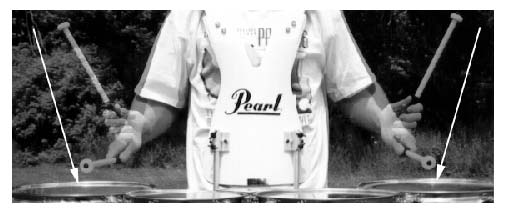
The following is an excerpt from Bill Bachman's book, "Quad Logic". If you'd like to order a copy, please contact Bill at Opiedrums@aol.com or visit his website at http://www.LogicalPress.com
CHAPTER 13
SCRAPES
Scrapes are one of the best reasons to play quads. Also commonly referred to as "sweeps," scrapes are defined as diddles that are played on two different drums, the first beat of the diddle on any one drum, and the second beat on a different drum. Scrapes are commonly used for three reasons: musicality, logistics, and glamour. Musically, scrapes can offer new effects through new drum-to-drum combinations; logistically, they can help move hands "out of the way," to make certain drum-to-drum combinations flow better. As far as glamour is concerned, scrapes just plain look cool!
The hand motions used when scraping diddles are no different than they are when playing diddles on one drum. All diddles should be played as two consecutive controlled legato strokes on a hand, using a combination of wrist, fingers, and at fast tempos, forearms.
There are really only two types of scrapes: those scraping outward, away from the center of the body, and those scraping inward, towards the center of the body. There are no special considerations needed for playing outward scrapes. When playing INWARD scrapes, however, it's helpful to turn your hands up a little so that the mallet downstrokes toward the first drum at an angle. The faster the tempo/lower the mallet height, the shallower the angle of the initial downstroke. Although the hands themselves are turned up a little, the hand motion doesn't change. DO NOT play inward scrapes with a "French Grip;" the fulcrum must still be located where the player can control the mallet's side-to-side motion and his/her fingers can control both beats of each diddle (check out the following picture):

| NOTE: The slight turning up of the hands should happen naturally as one tries to play inward scrapes with the hands flat. |
When playing scrapes, it is imperative not to just "go with the flow" of the forearm's motions; one must know exactly where each beat of each scrape is contacting the drums. For ease of movement and conservation of motion, be sure to play in the "scrape playing areas" (as shown in chapter 5 on set positions/playing areas). It is also sometimes helpful to think about the three gaps between the drums rather than the four drums themselves. Proper scrape technique can be summed up as this: the hands turn from the wrist and incorporate the use of fingers in order to play excellent quality diddles, while the forearms move the hands where they need to go around the drums. This is the key to playing scrapes with great sound quality.
Now that the technique has been broken down, it's time to get behind the drums and play some quality scrapes. Remember to periodically review the "12 GOLDEN QUAD RULES" on page 22.


| NOTE: The forthcoming notes notated with x's are cross-overs. To better understand these, refer to Chapter 7 on cross-overs. |

If you'd like to print out a clean copy of the "Scrapes" chapter from Bill Bachman's book "Quad Logic," download this Acrobat PDF file. You'll need the free Acrobat Reader plugin (available here). Don't forget that if you like these exercises, you can get the whole book by contacting Bill or by visiting his website at http://www.LogicalPress.com.

Bill Bachman has studied percussion performance at the University of North Texas and is a graduate of the Berklee College of Music. He has played quads in the University of North Texas indoor drumline, the Cadets of Bergen County Drum and Bugle Corps and has instructed with many award-winning groups including the Bluecoats and Blue Knights Drum and Bugle Corps.
But wait, there's more! Try your hand(s) at "Beatlicious," difficult solo from Bill's book! We've got some video to help you learn the solo, plus a PDF file that you can print on the next page!
Beatlicious |



